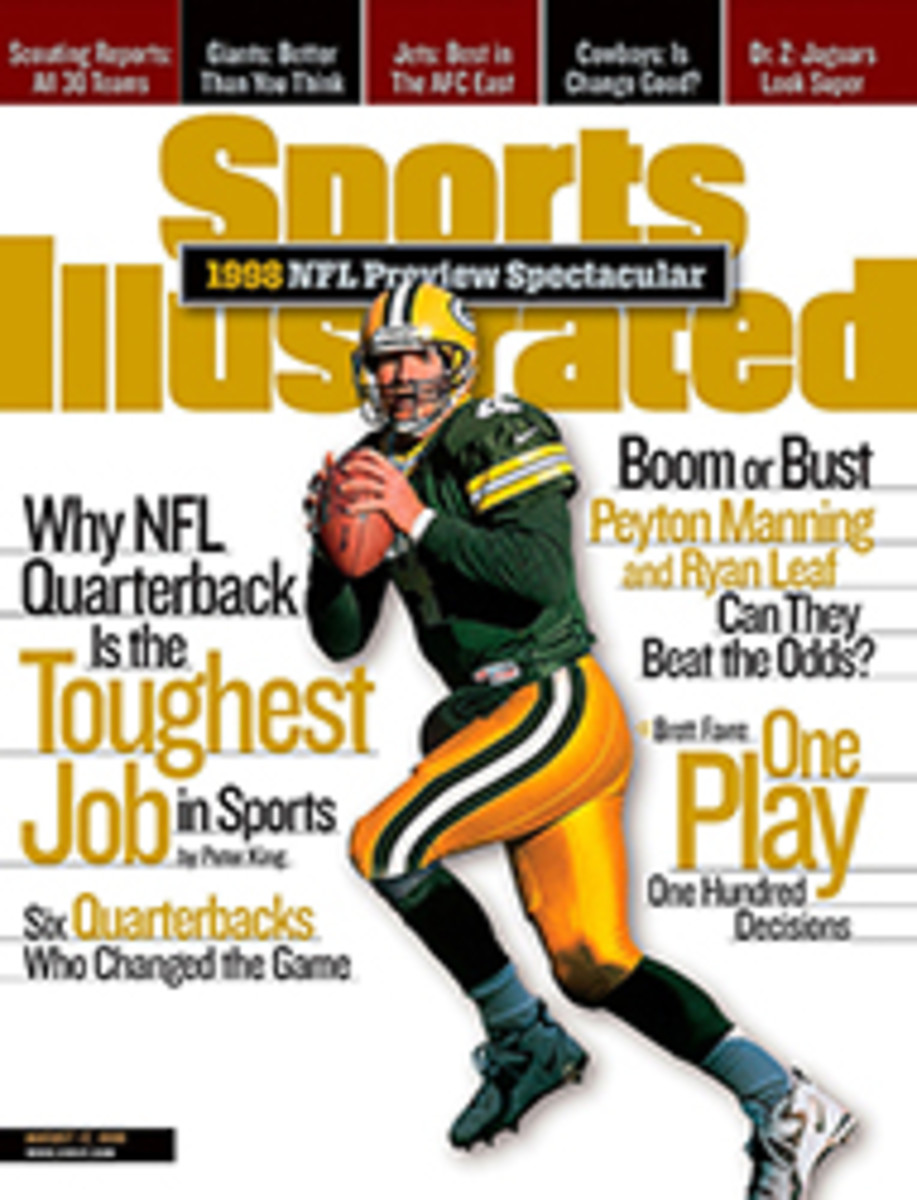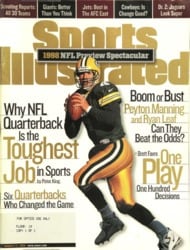
The Byte Stuff What happens when the biggest name in the computer industry interfaces with golf?
On the contents page of the current issue of Rolling Stone, on
which the magazine's Hot List appears, assistant managing editor
Will Dana writes, "The profoundly uncool can also be profoundly
hot, a seeming contradiction known as the Bill Gates Paradox."
Turns out that the Gates Paradox applies nicely to golf, and
Gates himself is a recent convert to the hottest of sports. The
world's richest man has not only taken up the game but has also
become an unlikely pitchman for Callaway. The relationship
between Gates and golf is being cemented this week at the PGA
Championship in Redmond, Wash., at Sahalee Country Club, which
is only four miles up the road from the four-million-square-foot
home of Gates's monster computer software company, Microsoft.
Microsoft is one of the championship's corporate sponsors, and
Gates planned to make the rounds at Sahalee, where he will hear
about the tournament the PGA Tour hopes to inaugurate next
summer at the nearby TPC at Snoqualmie Ridge. A title sponsor is
still being sought.
Of course, a Tour event is only "real golf," as Microsofties
dismissively call it. Microsoft is one of the biggest players in
computer golf games, which easily outsell games for every other
sport. With all this synergy involving golf, Gates and
Microsoft, we visited the Redmond campus to explore the
company's golf culture, real and otherwise. We found a horribly
disfigured Gumby, quarter Osgoods, a brief dissertation on
mockingbird calls and some insight into the world's most
celebrated 26 handicapper.
It began innocently enough, years ago, when Ed Fries was a
programmer pulling insane hours while developing the Excel
spreadsheet. Fries brought a putter and a few balls to the
office as a stress reliever, and soon he and a handful of
colleagues were puttering about the carpeted hallways late at
night. Thus was born the Swing Around the Wing, a putting
contest whose growth, proclaim longtime participants, dwarfs
Microsoft's rise in the computer world. The Swing has evolved
into a Friday-evening staple on the second floor of Building A
on Microsoft's West campus (RedWest), home to the games
division. Tee times are made throughout the day via E-mail, and
around five o'clock the first sixsome is sent off to navigate a
lap around the floor, holing out in a yellow Nerf cup. As many
as 60 people play on any given Friday, but not Gates, though on
at least one occasion he has joined the gallery. Scores are
assiduously kept on a spreadsheet, with the winner earning
weeklong possession of the Gumbopolis, a foot-tall plastic Gumby
that has been rendered virtually unrecognizable through years of
abuse. "Each week the winner has to add something as
decoration," Fries wrote me. (Fittingly, I never met Fries; we
corresponded only through E-mail and phone tag.) "By the end of
the first year it was a huge trophy with blinking lights and all
sorts of crap on it. Definitely the work of a committee."
The Swing is surprisingly competitive, with unyielding
enforcement of only one rule. "In the Scottish tradition, we
play the ball where it lies," says Ted Stamps, a programmer with
Microsoft Golf 98. Stories about recovery shots from potted
plants and sofa cushions, even off computer keyboards, are
legion. Complicating matters is the long-standing tradition of
the office staff's placing detritus in the hallway as hazards.
Surprisingly, there has been only minimal damage over the
years--at last count more than 50,000 putts had been logged into
the database--hence the motto, Over 50,000 strokes without a
serious injury or death. One noteworthy bit of destruction came
courtesy of Nate Osgood, an intern. On his first swing Osgood
uncorked a shank of such force that his ball left a cavity, with
dimples, in a wall. Christening the damage "a full Osgood,"
Fries wrote, "we knew then that that would be the mark by which
all other marks are judged." According to Microsoft's
frighteningly efficient p.r. department, there are 27 ball
indentations (and six club impressions) on the walls of RedWest.
Some are quarter Osgoods, some half. There is, however, only one
full Osgood.
Even in the dressed-down world of computing, Microsoft is a
casual place. There is no dress code, and the slovenliness of
most of the offices would make an eight-year-old cringe. But
even grading on a curve, RedWest C has a mellow vibe. Home to
the company's audio department, the C building's walls are
groovy shades of deep blue and purple, and every soundstage is
named for a popular musician. Matt Johnston is slouched in Karen
Carpenter, idly strumming an unplugged Fender Stratocaster,
discussing, in his languid surfer-dude diction, his job, which
may be the coolest at Microsoft. In addition to a scruffy
goatee, he's wearing corduroy shorts, an old-school Atari
T-shirt, seven rings, three bracelets and three earrings. The
only things missing are a lava lamp and a pack of Zig Zags.
"See, you can't just have one mockingbird call," Johnston says.
"They sound different depending on the time of day and when
they're calling to each other. So we programmed in 10 different
calls. Take a listen."
In his guise as a senior audio designer, Johnston travels to the
courses that Microsoft re-creates in its golf games and records
the sounds, everything from indigenous wildlife to stray
helicopters. Johnston produces what he calls the site-specific
"binaural ambiance sound files" that are put into the games. One
side of a fairway might contain the sound of an aroused male
mockingbird in midmorning, the other side something completely
different--like, say, the muffled patter from two employees
hanging out in a utility shed.
According to Johnston, the best-sounding course he has visited
is Mauna Kea, in Hawaii, because it lacks industrial noise. Like
most golf games, Microsoft's are skewed toward exotic courses,
such as Mauna Kea or Teeth of the Dog, in the Dominican
Republic. Though Johnston appreciates the aesthetics of these
tracks, he would like to see a more common touch in Microsoft's
games. "I've been saying for a long time that we should do a
muni course," he says. "Someplace full of divots and ball marks.
When I play, I always just go to the local munis, crack a
twelver of Bud with some buddies, and hack and slash."
Johnston, though, is not part of the Dawn Patrol, a sizable
group of avid golfers from Microsoft who play in the morning
before work, often at Bellevue Municipal, across the street from
RedWest. (Thankfully, RedWest has a locker room and showers.)
Of Microsoft's 27,320 employees, an estimated 10% are
stock-option millionaires, and many of the well-heeled play at
the plush country clubs around Seattle. Four clubs are
particularly popular: Bear Creek, a demanding layout with no
pool or tennis courts that attracts serious players; the
Plateau, a brand-new facility that is courting families;
Overlake, a distinguished club where it's said that the average
age of the membership is dead; and Sahalee, the most prestigious
of the bunch. Gates plays out of Broadmoor Country Club, which
is 10 minutes east of downtown Seattle and known for its huge
fairways and small greens.
Uh, Matt, have you teed it up with Gates yet? This brings only a
smile.
"Bill's not a handicap whiner. He's not looking for a lot of
extra strokes," says Pete Higgins, Microsoft's group vice
president for interactive media and a frequent playing partner
of Gates's. "He's a pretty straightforward guy, a pretty
straightforward golfer." With his 4.3 index Higgins is the best
stick among Microsoft executives, and he's more than 20 pops
better than Gates, whom the Broadmoor lists at 26. But they do
fine together, in part, says Higgins, because "Bill's one of the
fastest players I know."
The word according to various insiders is that Gates is short
off the tee, plays a little fade and is pretty good around the
greens. He is loyal to his Callaway clubs and laid-back on the
course, in contrast to the tart tongue and Vesuvian temper he is
famous for in the boardroom. Oh, yeah, one other thing: Gates
likes to play skins games, for a dollar a hole, and according to
Higgins, "You don't ever have to tell Bill the score. He knows.
Very competitive individual."
Having competed in the company's annual tournament, at Harbor
Point in nearby Edmonds, and having played numerous casual
rounds with a cross section of his colleagues, Higgins is
qualified to describe the average Microsoft golfer. "Picture a
bunch of engineers, each with about eight swing thoughts in his
head," he says. "There are a lot of tortured swings."
It's nice to know there's something that all those smarty-pants
Microsofties haven't figured out yet.
COLOR ILLUSTRATION: ILLUSTRATIONS BY RANDY DAHLK You da man Gates, a 26 handicapper, plays for $1 skins and always knows the score. [Drawing of Bill Gates golfing]
TWO COLOR ILLUSTRATIONS: ILLUSTRATIONS BY RANDY DAHLK SWING SET The winner of the hallway putting contest at RedWest gets to leave his mark on Gumbopolis (below). [Woman hitting golf ball on computer keyboard with golf club; drawing of decorated Gumby doll]
Stories about recovery shots from potted plants and off computer
keyboards are legion.

